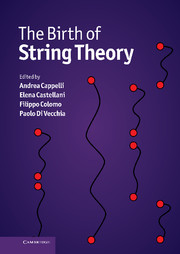Book contents
- Frontmatter
- Contents
- List of contributors
- Photographs of contributors
- Preface
- Abbreviations and acronyms
- Part I Overview
- EARLY STRING THEORY
- Part II The prehistory: the analytic S-matrix
- Part III The Dual Resonance Model
- Part IV The string
- TOWARDS MODERN STRING THEORY
- Part V Beyond the bosonic string
- 27 Introduction to Part V
- 28 From dual fermion to superstring
- 29 Dual model with fermions: memoirs of an early string theorist
- 30 Personal recollections
- 31 Aspects of fermionic dual models
- 32 The dual quark models
- 33 Remembering the dawn of relativistic strings
- 34 Early string theory in Cambridge: personal recollections
- Part VI The superstring
- Part VII Preparing the string renaissance
- Appendix A Theoretical tools of the Sixties
- Appendix B The Veneziano amplitude
- Appendix C From the string action to the Dual Resonance Model
- Appendix D World-sheet and target-space supersymmetry
- Appendix E The field theory limit
- Index
29 - Dual model with fermions: memoirs of an early string theorist
from Part V - Beyond the bosonic string
Published online by Cambridge University Press: 05 May 2012
- Frontmatter
- Contents
- List of contributors
- Photographs of contributors
- Preface
- Abbreviations and acronyms
- Part I Overview
- EARLY STRING THEORY
- Part II The prehistory: the analytic S-matrix
- Part III The Dual Resonance Model
- Part IV The string
- TOWARDS MODERN STRING THEORY
- Part V Beyond the bosonic string
- 27 Introduction to Part V
- 28 From dual fermion to superstring
- 29 Dual model with fermions: memoirs of an early string theorist
- 30 Personal recollections
- 31 Aspects of fermionic dual models
- 32 The dual quark models
- 33 Remembering the dawn of relativistic strings
- 34 Early string theory in Cambridge: personal recollections
- Part VI The superstring
- Part VII Preparing the string renaissance
- Appendix A Theoretical tools of the Sixties
- Appendix B The Veneziano amplitude
- Appendix C From the string action to the Dual Resonance Model
- Appendix D World-sheet and target-space supersymmetry
- Appendix E The field theory limit
- Index
Summary
Abstract
I worked on string theory over a period of five years during the ‘first string era’, the most intellectually satisfying years of my scientific life. One of the early prospectors in the string theory mine, I was fortunate enough to contribute to the birth of this subject, which retains after these many years, its magical hold on our imaginations and expectations.
Graduate school
I was born in Neuilly sur Seine, a suburb of Paris, where I attended Sainte Croix de Neuilly. After the ‘deuxième bachot’ in 1961, I decided to spend a year with my family in New Jersey, where my civil engineer father had been working for a company that designed and manufactured concrete pipes. I enrolled at the Newark College of Engineering (NCE); there, I found spectacular teachers, especially Dr Foster, and one year turned into four; I graduated in 1965 with a Bachelor of Science in electrical engineering.
Always interested in physics, I had studied the subject on my own while at NCE. My application to Princeton graduate school in physics was rejected (and wait-listed at Yale). Fortunately, I had also applied to Syracuse University where Peter Bergmann was teaching. With the recommendations of Professors Henry Zatzkis (a student of Bergmann), Mauro Zambuto, and A. E. Foster, I was accepted, and soon afterwards, awarded a four-year fellowship.
I had wanted to study general relativity with Bergmann, but I was persuaded by Professor Alan McFarlane to switch to particle physics and join the group headed by E. C. G. Sudarshan.
- Type
- Chapter
- Information
- The Birth of String Theory , pp. 361 - 372Publisher: Cambridge University PressPrint publication year: 2012
- 2
- Cited by

